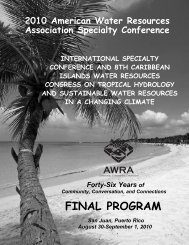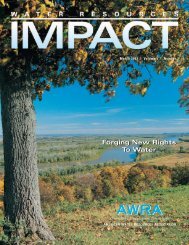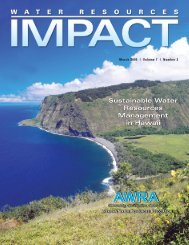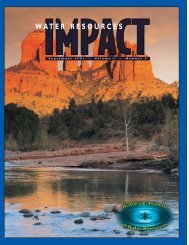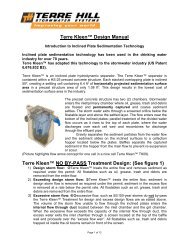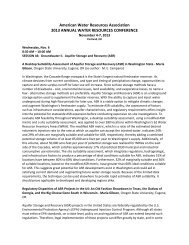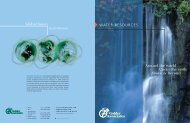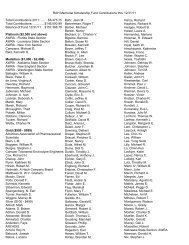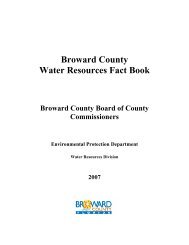N ovember 2 0 0 0 ⢠V olume 2 ⢠N umber 6 - American Water ...
N ovember 2 0 0 0 ⢠V olume 2 ⢠N umber 6 - American Water ...
N ovember 2 0 0 0 ⢠V olume 2 ⢠N umber 6 - American Water ...
Create successful ePaper yourself
Turn your PDF publications into a flip-book with our unique Google optimized e-Paper software.
The New <strong>Water</strong>shed Tools – Genuine Steel or Chrome-Plated Plastic? . . . cont’d.<br />
and 1992 (Langland et al., 1995). The error has been acknowledged<br />
by an author of the USGS report. Nevertheless,<br />
these nonexistent data were used – and are still<br />
being used – to calibrate and verify the Chesapeake Bay<br />
Model, a computerized environmental simulation that influences<br />
thousands of land use decisions affecting the<br />
lives of millions of people.<br />
Writing in 1993, Knopman and USGS hydrologist<br />
Richard Smith, expressed hope that full implementation<br />
of a new long-term National <strong>Water</strong> Quality Assessment<br />
would correct the sins of omission in USGS data and<br />
bring “accurate and meaningful water quality information<br />
to the forefront of the policy debate” (Knopman and<br />
Smith, 1993). Those expectations have been disappointed.<br />
Monitoring of the Potomac River watershed, for example,<br />
was discontinued after only three years. Federal<br />
agencies now characterize nutrient concentrations in the<br />
watershed from monthly samples at only 11 sites in the<br />
15,000 square-mile basin over three years, 1993-1995 –<br />
a wholly inadequate record by USGS’s own standards<br />
(Ator et al., 1998). The federal government continues to<br />
suggest that these data are appropriate for management<br />
decisions in the Chesapeake Bay watershed.<br />
From 1988 to 1990, an attempt by Purdue University<br />
professor Steven Lovejoy to analyze nutrient contributions<br />
of major tributaries to the Mississippi River using<br />
USGS data ended in frustration. According to Lovejoy, he<br />
and research associate Barbara Dunkelberg spent weeks<br />
“trying to make sense” of the data coming out of EPA’s<br />
STORET data dump. They finally “gave it up,” Lovejoy reports,<br />
because the n<strong>umber</strong>s coming out of the database<br />
were simply not credible (Stephen B. Lovejoy, October 9,<br />
2000, personal communication). In his 1992 report published<br />
by EPA, Lovejoy states that the USGS data “are not<br />
comparable in their timeframes, methods employed, or<br />
the water quality parameters reported.” In addition “data<br />
on nutrient concentrations in rivers often are not accompanied<br />
by data on water flow,” making it impossible to<br />
determine nutrient loadings. Moreover, Lovejoy observed,<br />
“Federal budget constraints have led to bimonthly and<br />
quarterly sampling, leading to a very low n<strong>umber</strong> of measurements”<br />
for large geographic areas during particular<br />
seasons and for many of the years in the record. “The<br />
measurements of actual concentrations of pollutants and<br />
flows were nonexistent, both temporally and spatially,”<br />
he concluded (Lovejoy, 1992).<br />
Surprisingly, however, these same data, decisively<br />
rejected as useless in 1992, apparently constitute a key<br />
portion of the database of a new USGS model that purports<br />
to trace nutrients in the Mississippi River to their<br />
sources in upper basin tributaries. A Federal task force is<br />
also using these data to argue that nitrogen concentrations<br />
in the basin have increased by two to three-fold<br />
since the mid-20th century and must be reduced by draconian<br />
changes in land use. Ultimately, the task force<br />
hopes to create Federally-inspired land use policies in the<br />
states of the Mississippi Basin based on this analysis.<br />
The changes in land use policy may be desirable from<br />
some environmental and even economic points of view,<br />
but the use of deficient data makes the policy goals<br />
suspect and vulnerable to challenge-both scientifically<br />
and legally.<br />
Data proposed by EPA for use in the BASINS watershed<br />
model also came under unfavorable scrutiny recently.<br />
In a less-than-flattering critique of the model in<br />
the Journal of the <strong>American</strong> <strong>Water</strong> Resources Association,<br />
Ray Whittemore and John Beebe (2000) warn that<br />
many records from the EPA Office of <strong>Water</strong> “are incomplete<br />
or suggest data quality that does not comply with<br />
the content of the standard for digital geospatial data.”<br />
The reviewers observe, “stakeholders in contentious [watershed<br />
management decisions] . . . will demand that the<br />
tools be of unquestionable veracity when faced with expensive<br />
treatment upgrades or restrictive land management<br />
BMPs” – and rightly so.<br />
DATA QUALITY: WHAT ME WORRY?<br />
Unfortunately, not everyone worries about the<br />
soundness of our data. The TMDL debate this spring<br />
illustrated that the professional water resource community<br />
must shoulder the burden of demanding quality data<br />
– or no one will. In May, the lobbying and maneuvering<br />
surrounding the rulemaking became intense. Six mainstream<br />
environmental organizations – apparently indifferent<br />
to the data quality issues – wrote to EPA Administrator<br />
Carol Browner complaining that “comprehensive<br />
TMDLs” were to have been developed and implemented,<br />
and water quality standards fully attained by 1984. They<br />
charged that further delays of “up to 15 years” for 40,000<br />
TMDLs to be developed was “unconscionable and contrary<br />
to law.”<br />
Testifying before a subcommittee of the Senate Committee<br />
on Environment and Public Works last March, Executive<br />
Director of the Northwest Environmental Advocates<br />
Nina Bell acknowledged the “states do not collect<br />
adequate data” and that “the data states do collect<br />
are neither comprehensive in geographic scope nor in<br />
sufficient depth on individual waterbodies to develop<br />
TMDLs ...” But because we face imminent environmental<br />
and public health catastrophes, Bell claimed, we should<br />
“[count] on public policy to fill in the gaps ...” (Bell, 2000).<br />
There seems to be little awareness within some concerned<br />
communities, that without credible data, environmental<br />
policy simply becomes one sector’s forcing<br />
lifestyle choices on other sectors of society – without reference<br />
to any objective reality. Policy is made the strong<br />
arm of prejudice. It may be so in Congress, but it ought<br />
not be so in the professional water resources community.<br />
THE PERILS OF MODELING<br />
The EPA clearly hopes that BASINS and models like<br />
it will be used to manage tens of thousands of watersheds<br />
around the country for which poor or no monitoring data<br />
exist. Without good long-term records it is impossible to<br />
produce coherent and defensible management goals. The<br />
lack of real world data will mean that instead of credible<br />
watershed-specific information, models will be forced to<br />
rely on questionable defaults – one time grab samples,<br />
24 • <strong>Water</strong> Resources IMPACT N<strong>ovember</strong> • 2000



